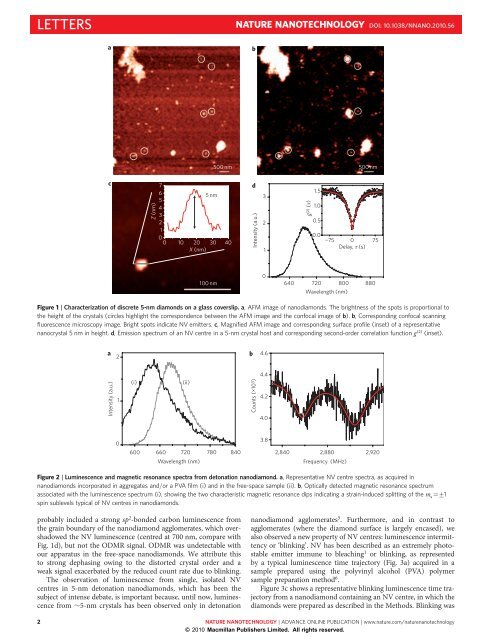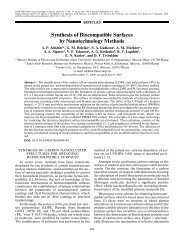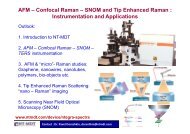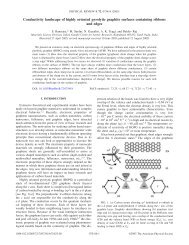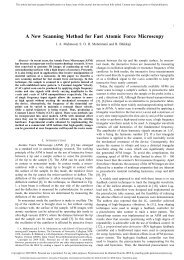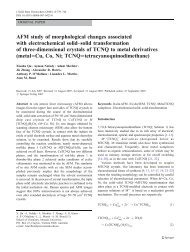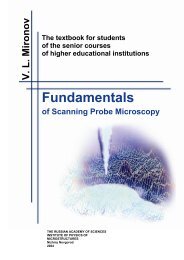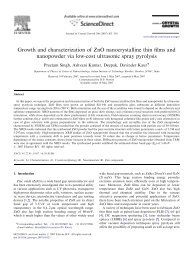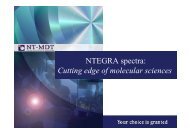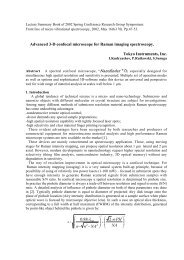LETTERSNATURE NANOTECHNOLOGY DOI: 10.1038/NNANO.2010.56ab500 nm500 nmcZ (nm)7d655 nm 34322100 10 20 30 40X (nm)1Intensity (a.u.)g (2) (τ)1.51.00.50.0−75 0 75Delay, τ (s)100 nm0640 720 800 880Wavelength (nm)Figure 1 | Characterization <strong>of</strong> discrete 5-nm diamonds on a glass coverslip. a, AFM image <strong>of</strong> nanodiamonds. The brightness <strong>of</strong> the spots is proportional tothe height <strong>of</strong> the crystals (circles highlight the correspondence between the AFM image <strong>and</strong> the confocal image <strong>of</strong> b). b, Correspond<strong>in</strong>g confocal scann<strong>in</strong>gfluorescence microscopy image. Bright spots <strong>in</strong>dicate NV emitters. c, Magnified AFM image <strong>and</strong> correspond<strong>in</strong>g surface pr<strong>of</strong>ile (<strong>in</strong>set) <strong>of</strong> a representativenanocrystal 5 nm <strong>in</strong> height. d, Emission spectrum <strong>of</strong> an NV centre <strong>in</strong> a 5-nm crystal host <strong>and</strong> correspond<strong>in</strong>g second-order correlation function g (2) (<strong>in</strong>set).a2b 4.6Intensity (a.u.)1(i)(ii)Counts (×10 3 )4.44.24.00600 660 720 780 840Wavelength (nm)3.82,840 2,880 2,920Frequency (MHz)Figure 2 | Lum<strong>in</strong>escence <strong>and</strong> magnetic resonance spectra from detonation nanodiamond. a, Representative NV centre spectra, as acquired <strong>in</strong>nanodiamonds <strong>in</strong>corporated <strong>in</strong> aggregates <strong>and</strong>/or a PVA film (i) <strong>and</strong> <strong>in</strong> the free-space sample (ii). b, Optically detected magnetic resonance spectrumassociated with the lum<strong>in</strong>escence spectrum (i), show<strong>in</strong>g the two characteristic magnetic resonance dips <strong>in</strong>dicat<strong>in</strong>g a stra<strong>in</strong>-<strong>in</strong>duced splitt<strong>in</strong>g <strong>of</strong> the m s ¼+1sp<strong>in</strong> sublevels typical <strong>of</strong> NV <strong>centres</strong> <strong>in</strong> nanodiamonds.probably <strong>in</strong>cluded a strong sp 2 -bonded carbon lum<strong>in</strong>escence fromthe gra<strong>in</strong> boundary <strong>of</strong> the nanodiamond agglomerates, which overshadowedthe NV lum<strong>in</strong>escence (centred at 700 nm, compare withFig. 1d), but not the ODMR signal. ODMR was undetectable withour apparatus <strong>in</strong> the free-space nanodiamonds. We attribute thisto strong dephas<strong>in</strong>g ow<strong>in</strong>g to the distorted crystal order <strong>and</strong> aweak signal exacerbated by the reduced count rate due to <strong>bl<strong>in</strong>k<strong>in</strong>g</strong>.The observation <strong>of</strong> lum<strong>in</strong>escence from s<strong>in</strong>gle, isolated NV<strong>centres</strong> <strong>in</strong> 5-nm detonation nanodiamonds, which has been thesubject <strong>of</strong> <strong>in</strong>tense debate, is important because, until now, lum<strong>in</strong>escencefrom ≏5-nm crystals has been observed only <strong>in</strong> detonationnanodiamond agglomerates 5 . Furthermore, <strong>and</strong> <strong>in</strong> contrast toagglomerates (where the diamond surface is largely encased), wealso observed a new property <strong>of</strong> NV <strong>centres</strong>: lum<strong>in</strong>escence <strong>in</strong>termittencyor ‘<strong>bl<strong>in</strong>k<strong>in</strong>g</strong>’. NV has been described as an extremely photostableemitter immune to bleach<strong>in</strong>g 1 or <strong>bl<strong>in</strong>k<strong>in</strong>g</strong>, as representedby a typical lum<strong>in</strong>escence time trajectory (Fig. 3a) acquired <strong>in</strong> asample prepared us<strong>in</strong>g the polyv<strong>in</strong>yl alcohol (PVA) polymersample preparation method 6 .Figure 3c shows a representative <strong>bl<strong>in</strong>k<strong>in</strong>g</strong> lum<strong>in</strong>escence time trajectoryfrom a nanodiamond conta<strong>in</strong><strong>in</strong>g an NV centre, <strong>in</strong> which thediamonds were prepared as described <strong>in</strong> the Methods. Bl<strong>in</strong>k<strong>in</strong>g was2NATURE NANOTECHNOLOGY | ADVANCE ONLINE PUBLICATION | www.nature.com/naturenanotechnology© 2010 Macmillan Publishers Limited. All rights reserved.
NATURE NANOTECHNOLOGY DOI: 10.1038/NNANO.2010.56LETTERSabPhotocounts per4-ms b<strong>in</strong>400200Photocounts per4-ms b<strong>in</strong>4002000 1 2 0 400 800Time (s)OccurrencecdPhotocounts per4-ms b<strong>in</strong>400200Photocounts per4-ms b<strong>in</strong>400200eOccurrence01 2 0 400 80010 0 10 0Time (s)Occurrence10 3 f 10 39020601710 210 214300.4 0.6 0.80.4 0.6 0.8Laser <strong>in</strong>tensityLaser <strong>in</strong>tensity10 1(MW cm −2 )10 1(MW cm −2 )τ on (ms)Occurrenceτ <strong>of</strong>f (ms)0 75 150 225 300075150‘On’ time <strong>in</strong>terval (ms)‘Off’ time <strong>in</strong>terval (ms)Figure 3 | Detailed analysis <strong>of</strong> <strong>bl<strong>in</strong>k<strong>in</strong>g</strong> statistics from an NV centre <strong>in</strong> detonation nanodiamond. a–d, A 2-s fragment <strong>of</strong> a 200-s lum<strong>in</strong>escence timetrajectory <strong>of</strong> the NV <strong>centres</strong> sampled <strong>in</strong>to 4-ms b<strong>in</strong>s from two separate diamond samples: NV lum<strong>in</strong>escence from nanodiamonds embedded <strong>in</strong> a PVApolymer film (a), with correspond<strong>in</strong>g histogram fitted with a s<strong>in</strong>gle Gaussian (b), where the l<strong>in</strong>e <strong>in</strong> a is the mean count rate; a s<strong>in</strong>gle isolated NV <strong>in</strong>nanodiamond display<strong>in</strong>g <strong>in</strong>termittent lum<strong>in</strong>escence (c), with correspond<strong>in</strong>g histogram <strong>of</strong> the full time trajectory fitted with two Gaussians (d). Gaussians arefitted to the ‘on’ <strong>and</strong> ‘<strong>of</strong>f’ state photon distributions <strong>and</strong> a l<strong>in</strong>e is drawn through c to <strong>in</strong>dicate the on/<strong>of</strong>f ‘threshold’ for analys<strong>in</strong>g the emission statistics.e,f, Bl<strong>in</strong>k<strong>in</strong>g statistics <strong>of</strong> the ‘on’ <strong>and</strong> ‘<strong>of</strong>f’ states on a semi-logarithmic scale (symbols). A s<strong>in</strong>gle exponential is fitted <strong>in</strong> both cases, with time constants 45<strong>and</strong> 18 ms, respectively. Insets to e <strong>and</strong> f plot <strong>bl<strong>in</strong>k<strong>in</strong>g</strong> time constant versus the excitation laser <strong>in</strong>tensities for ‘on’ <strong>and</strong> ‘<strong>of</strong>f’ states, respectively.observed <strong>in</strong> ≏25% <strong>of</strong> the lum<strong>in</strong>escent sites. The ‘<strong>of</strong>f’ state was at thelevel <strong>of</strong> the background signal, <strong>and</strong> <strong>bl<strong>in</strong>k<strong>in</strong>g</strong> due to photochromism16 was ruled out as the neutral NV lum<strong>in</strong>escence signaturewas never observed <strong>in</strong> the spectra. Photobleach<strong>in</strong>g was also observedon some <strong>of</strong> the <strong>centres</strong>; however, those analysed <strong>in</strong> this Lettershowed lum<strong>in</strong>escence over several hours <strong>of</strong> illum<strong>in</strong>ation. We analysed<strong>bl<strong>in</strong>k<strong>in</strong>g</strong> by sampl<strong>in</strong>g the lum<strong>in</strong>escence time trajectories at4-ms time b<strong>in</strong>s <strong>and</strong> analysed the data us<strong>in</strong>g accepted signal-process<strong>in</strong>galgorithms, <strong>in</strong> which the position <strong>of</strong> the signal relative to athreshold level determ<strong>in</strong>es the assignment <strong>of</strong> the states 17 . The <strong>bl<strong>in</strong>k<strong>in</strong>g</strong>phenomena were also characterized as a function <strong>of</strong> the excitation<strong>in</strong>tensity (shown <strong>in</strong> the <strong>in</strong>sets <strong>of</strong> Fig. 3e,f, <strong>and</strong> detailed <strong>in</strong>the Supplementary Information).The 4-ms b<strong>in</strong> width was chosen because it provides the deepestm<strong>in</strong>imum between the two Gaussian curves shown <strong>in</strong> Fig. 3d.Averag<strong>in</strong>g data <strong>in</strong>to 4-ms b<strong>in</strong>s on the one h<strong>and</strong> ignores the rapidevents that may display complex dynamics 18 , but on the otherh<strong>and</strong> decreases the noise <strong>and</strong> emphasizes the two-state NV-nanodiamond<strong>bl<strong>in</strong>k<strong>in</strong>g</strong> system, as shown <strong>in</strong> Fig. 3d. Chang<strong>in</strong>g the b<strong>in</strong>time to 2 ms did not change the result, <strong>and</strong> with 1-ms b<strong>in</strong>s thestatistical noise was too pronounced for a mean<strong>in</strong>gful result.These two states are identified as ‘on’ <strong>and</strong> ‘<strong>of</strong>f’ 19 . Quantum dots 20 ,s<strong>in</strong>gle molecules 21 , silicon nanocrystals <strong>in</strong> a porous siliconmatrix 22 <strong>and</strong> others 23 are well-known systems that show <strong>bl<strong>in</strong>k<strong>in</strong>g</strong>.The validity <strong>of</strong> the two-state on/<strong>of</strong>f model is <strong>in</strong>tensely debated 24 ,especially <strong>in</strong> the context <strong>of</strong> quantum-dot studies, where, forexample, three states 25 <strong>and</strong> a cont<strong>in</strong>uous distribution <strong>of</strong> states 26have been reported. In our case, the validity <strong>of</strong> the two-statemodel was underp<strong>in</strong>ned by the photon distribution <strong>in</strong> ‘on’ <strong>and</strong>‘<strong>of</strong>f’ states based on the Gaussian distribution <strong>and</strong> expressed as⎡ ( ) 2⎤PN ( ) = p N − ¯N onon√⎢⎥exp⎣−⎦2p son2s 2 on⎡ ( ) 2⎤+ p N − ¯N <strong>of</strong>f<strong>of</strong>f√⎢⎥exp⎣−⎦2p s<strong>of</strong>f2s 2 <strong>of</strong>fwhere ¯N represents the mean value <strong>of</strong> the number <strong>of</strong> photons <strong>in</strong>each state, p is the population <strong>of</strong> the states, N the total number <strong>of</strong>photons <strong>and</strong> s 2 the variance <strong>of</strong> the distribution. For a stablephoton emission, the variance equals the mean value. The fit tothe distribution reveals s 2 on to be only about two times largerthan the mean ¯N on . This determ<strong>in</strong>ed our choice <strong>of</strong> the thresholdlevel between the ‘on’ <strong>and</strong> ‘<strong>of</strong>f’ states, which was set at the <strong>in</strong>tersection<strong>of</strong> the two Gaussians (Fig. 3c,d), where the probabilities for N tobe at the ‘on’ <strong>and</strong> ‘<strong>of</strong>f’ levels were equal. The distribution <strong>of</strong> the ‘on’<strong>and</strong> ‘<strong>of</strong>f’ times are plotted on a semi-logarithmic scale <strong>in</strong> Fig. 3e,f,NATURE NANOTECHNOLOGY | ADVANCE ONLINE PUBLICATION | www.nature.com/naturenanotechnology 3© 2010 Macmillan Publishers Limited. All rights reserved.


